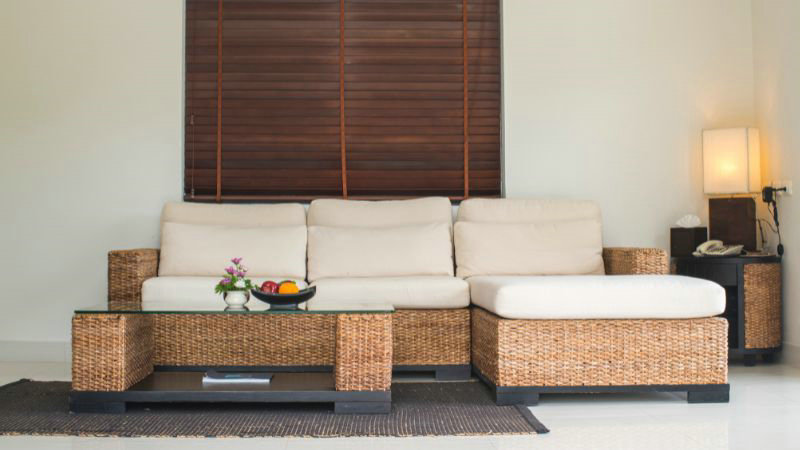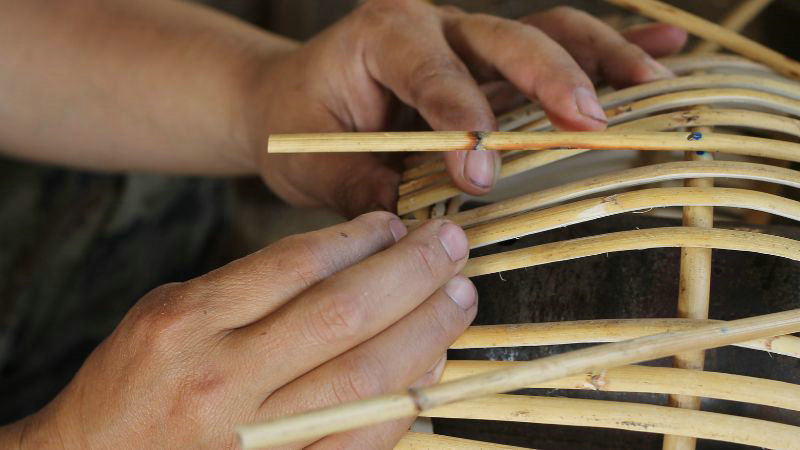When it comes to furniture, you might often find yourself wondering about the difference between rattan and cane.
Rattan is a material derived from the rattan palm, known for its sturdy, reedlike structure, making it ideal for creating frames for chairs, loveseats, and tables.
Cane, on the other hand, is a thinner material stripped from the outer layer of the rattan palm, often used in intricate woven patterns for the backrests of chairs and cabinet doors.

Both rattan and cane bring a natural, earthy charm to your home decor.
You’ll appreciate how these materials can transform a space, offering a blend of rustic elegance and modern style.
Understanding the unique qualities of rattan and cane will help you make informed choices for your furniture needs.
Rattan Furniture
Rattan furniture is crafted from the flexible stems of the rattan palm, which is known for its strength and durability. This type of furniture is often woven in intricate patterns, creating a distinctive aesthetic that is both elegant and natural.
Advantages
- Durability: Rattan furniture is highly durable and can withstand various weather conditions, making it suitable for outdoor use. When properly maintained, it can last for many years.
- Lightweight: Rattan is lightweight, allowing for easy rearrangement and mobility of furniture pieces.
- Eco-Friendly: Rattan is a sustainable material as it grows quickly and can be harvested without destroying the entire plant. This makes it an environmentally responsible choice.
- Versatility: Rattan furniture is versatile and can fit into various design styles, from traditional to modern. It can be used for different types of furniture, including chairs, tables, and sofas.
- Comfort: Rattan furniture can be designed ergonomically, and when paired with cushions, it provides a comfortable seating experience.
Disadvantages
- Susceptibility to Weather: Natural rattan can be damaged by prolonged exposure to moisture and sunlight, leading to fading, warping, or mold growth. This limits its outdoor usability without protective measures.
- High Maintenance: Rattan furniture requires regular cleaning and occasional treatment to maintain its appearance and durability. It is not considered low maintenance.
- Cost: High-quality rattan furniture can be expensive due to the craftsmanship involved in its production. Cheaper options may not provide the same durability.
- Comfort Issues: While rattan can be comfortable, its tight weave may not provide enough give, making it less comfortable without additional cushions.
Cane Furniture

Cane furniture refers to furniture made from the outer bark of the rattan plant. It is often used in a woven form, similar to rattan, but is generally thinner and less flexible.
Advantages
- Strength: Cane is known for its strength and durability, often lasting many years when properly cared for. It can withstand regular use and is resilient.
- Natural Aesthetic: Cane furniture has a natural look and texture, appealing to those who prefer an earthy and organic style in their decor.
- Lightweight: Like rattan, cane furniture is lightweight, making it easy to move and rearrange in various settings.
- Cost-Effectiveness: Cane furniture is often more affordable than solid wood or other materials, providing a budget-friendly option for stylish decor.
Disadvantages
- Limited Flexibility: Cane is less flexible than rattan, which can limit the complexity of designs and styles possible with cane furniture.
- Susceptibility to Damage: Cane can be prone to damage from moisture and harsh weather conditions, similar to rattan, necessitating careful maintenance.
- Comfort Issues: Cane furniture may also require cushions for comfort, as the hard surface can be less forgiving for prolonged sitting.
In summary, both rattan and cane furniture offer unique advantages and disadvantages. Rattan is known for its durability and aesthetic appeal, while cane is valued for its strength and cost-effectiveness.
Wicker
Wicker is not a material but rather a term that refers to the weaving technique itself. It can be made from any number of pliable materials, including rattan, willow, bamboo, reed, and even synthetic materials.
Natural Wicker
- Rattan: Rattan is one of the most common and durable materials used for wicker furniture. Rattan wicker is popular due to its strength and flexibility.
- Willow: Willow branches are also commonly woven to create wicker items. Willow wicker is more flexible than rattan and is often used in basket making.
- Bamboo: Bamboo can be used in wicker to make both furniture and smaller decorative objects. Bamboo is lightweight and has a naturally warm color, making it aesthetically appealing.
- Reed:Reed, often sourced from types of water-loving plants, is another natural material used in wicker. It’s often used in combination with other materials for decorative purposes, such as basket edging.
- Seagrass: Seagrass is a plant fiber that is often woven into wicker items like baskets and trays. It has a coarse texture and is quite durable.
Synthetic Wicker
- Resin (Polyethylene or PVC): Modern wicker furniture, especially outdoor furniture, often uses synthetic resin materials. Resin wicker is typically made from high-density polyethylene (HDPE) or polyvinyl chloride (PVC). These synthetic materials are designed to resemble natural wicker, but they resist moisture, UV rays, and temperature changes, making them ideal for outdoor use.
- Nylon or Polyester:Some synthetic wickers are woven from nylon or polyester to create durable, weather-resistant furniture. These wickers are lighter than resin wicker and can come in a variety of colors.
Cane Wicker
- Cane:As mentioned earlier, cane wicker is made from the outer skin of the rattan plant. It’s often used for finer weaving, typically for chair seats and backrests. The cane is natural looking, adding an elegant, traditional aesthetic.
In summary, rattan is the source material, cane is a processed part of rattan used for delicate weaving, and wicker is the technique that brings these materials together into functional and decorative items. While they are closely related, each plays a distinct role in the world of handcrafted furniture.
The Differences between Rattan and Cane
Rattan and cane are both natural materials derived from a type of palm plant. However, there are some important distinctions between the two in terms of their origins, structures, uses, and properties.

Structure and Appearance
- Texture
Rattan has a natural, somewhat rough texture and can vary in appearance depending on how it’s processed. It can be left whole with its skin intact or stripped down to reveal its solid core.
Cane is the smooth and glossy outer layer of the rattan vine, giving it a polished look.
- Color
Naturally, rattan maintains a golden or light brown color, but it can be stained or lacquered in various shades.
Cane is typically lighter in color, often a pale yellow or honey tone, and has a consistent hue with a glossy finish.
- Size
Rattan poles can vary in thickness, ranging from thin, flexible stems to thicker, more rigid stems.
Cane is generally processed into thin strips, which are then woven into patterns or used as binding material.
Uses
- Furniture
Due to its strength and flexibility, rattan is commonly used in making the frames of furniture such as chairs, sofas, and tables. The entire pole or its split form can be used for construction.
- Decor
Rattan is also utilized in making decorative items, handicrafts, and outdoor furniture.
- Baskets
Whole or split rattan is used in weaving baskets, providing a strong structural element.
- Woven Seats
Cane is most commonly used in the weaving of chair seats, backs, and other surfaces. The smooth, flexible strips are typically woven in a pattern to create a grid-like surface.
- Binders
Cane is also used as a binding material to wrap and secure joints in furniture.
- Rattan Furniture Finishing
The outer gloss of cane makes it ideal for creating visually appealing designs, adding a smooth, shiny finish to rattan furniture.
Processing and Workability

- Processing
Rattan’s core can be split, steamed, and bent into various shapes, allowing artisans to create complex furniture designs. When dried, rattan retains the shape it was molded into, making it ideal for structural applications.
Cane is harvested by peeling off the outer layer of the rattan vine, which is then soaked and processed into thin strips. This treatment allows the material to be woven or wrapped easily.
- Workability
Due to its solid nature, rattan requires more robust tools to cut and shape, especially when working with thicker sections.
Cane is more straightforward to work with for weaving and surface treatment and requires less intensive labor compared to the rattan core.
Rattan is a versatile, strong material commonly used to create furniture frames and structural elements, while cane, the outer layer of rattan, is primarily used for decorative weaving and binding. Both materials bring unique properties that complement each other in the creation of stylish, functional furniture and decorative items.



